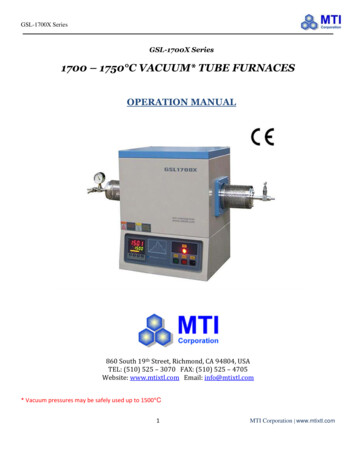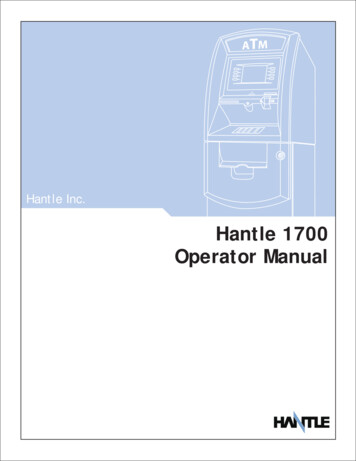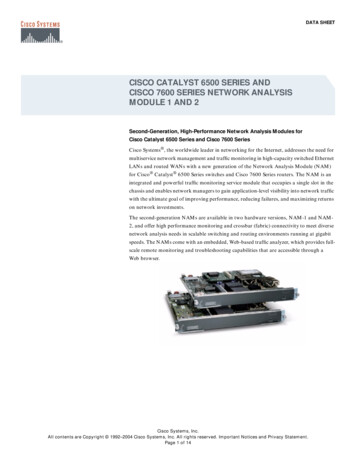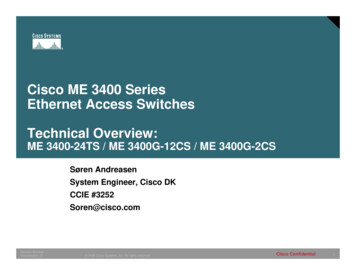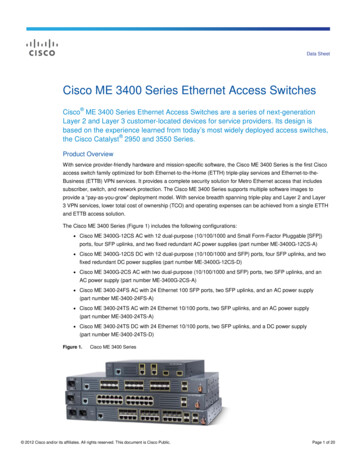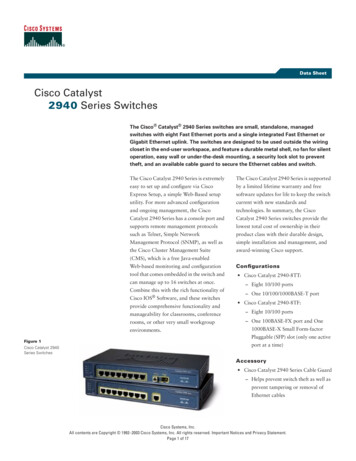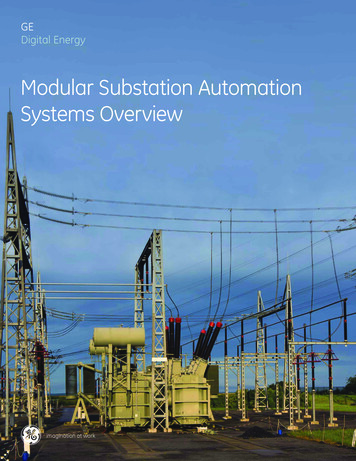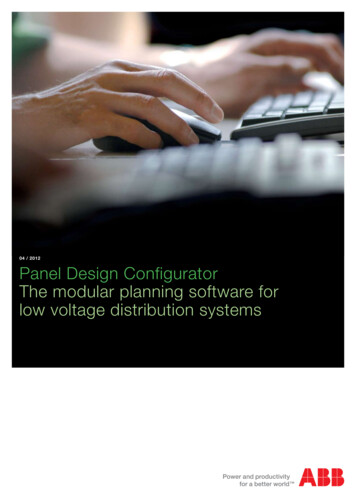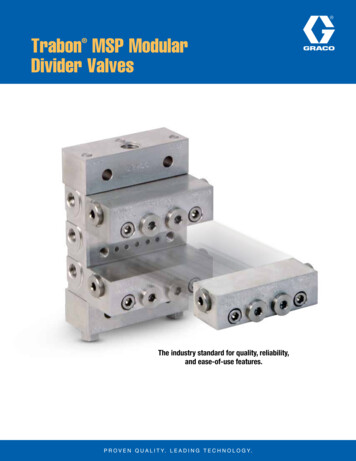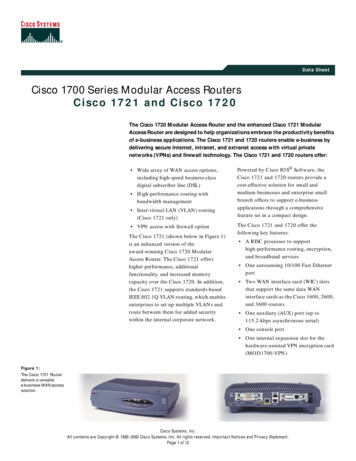
Transcription
Data SheetCisco 1700 Series Modular Access RoutersCisco 1721 and Cisco 1720The Cisco 1720 Modular Access Router and the enhanced Cisco 1721 ModularAccess Router are designed to help organizations embrace the productivity benefitsof e-business applications. The Cisco 1721 and 1720 routers enable e-business bydelivering secure Internet, intranet, and extranet access with virtual privatenetworks (VPNs) and firewall technology. The Cisco 1721 and 1720 routers offer: Wide array of WAN access options,including high-speed business-classdigital subscriber line (DSL) High-performance routing withbandwidth management Inter-virtual LAN (VLAN) routing(Cisco 1721 only) VPN access with firewall optionThe Cisco 1721 (shown below in Figure 1)is an enhanced version of theaward-winning Cisco 1720 ModularAccess Router. The Cisco 1721 offershigher performance, additionalfunctionality, and increased memorycapacity over the Cisco 1720. In addition,the Cisco 1721 supports standards-basedIEEE 802.1Q VLAN routing, which enablesenterprises to set up multiple VLANs androute between them for added securitywithin the internal corporate network.Powered by Cisco IOS Software, theCisco 1721 and 1720 routers provide acost-effective solution for small andmedium businesses and enterprise smallbranch offices to support e-businessapplications through a comprehensivefeature set in a compact design.The Cisco 1721 and 1720 offer thefollowing key features: A RISC processor to supporthigh-performance routing, encryption,and broadband services One autosensing 10/100 Fast Ethernetport Two WAN interface card (WIC) slotsthat support the same data WANinterface cards as the Cisco 1600, 2600,and 3600 routers One auxiliary (AUX) port (up to115.2-kbps asynchronous serial) One console port One internal expansion slot for thehardware-assisted VPN encryption card(MOD1700-VPN)Figure 1:The Cisco 1721 Routerdelivers a versatilee-business WAN accesssolution.Cisco Systems, Inc.All contents are Copyright 1992–2002 Cisco Systems, Inc. All rights reserved. Important Notices and Privacy Statement.Page 1 of 12
To see a comparison of the products, review Table 1 below.Table 1 Cisco 1721 and 1720 Product ComparisonFeatureCisco 1721Cisco 1720Routing Performance(based on 64-byte packet)12,000 packets per second8,400 packets per secondDRAM (default/maximum)32 MB/96 MB32 MB/48 MBFlash (default/maximum)16 MB/16 MB (Nonupgradable)8 MB/16 MBIEEE 802.1Q VLAN RoutingYesNoEncryption Module LED IndicatorYesNoThe Cisco 1700 Series supports the value of end-to-end Cisco network solutions with the following benefits: Flexibility—The modular Cisco 1721 and 1720 adapt easily to fit the needs of growing businesses.Interchangeable WAN interface cards enable easy additions or changes in WAN technologies without requiringa forklift upgrade of the entire platform. Modular data slots enable users to tailor data services as needed. Security—The Cisco 1721 and 1720 support hardware-assisted wire-speed Triple Digital Encryption Standard IPSecurity (3DES IPSec) VPN encryption (using optional VPN module), a Cisco IOS Software-based statefulinspection firewall, and an intrusion detection system (IDS) that allows customers to keep their data safe. Business-class DSL—Business-class DSL is delivered through the optional asymmetric DSL (ADSL) orsymmetrical high-bit rate DSL (G.shdsl) WICs. The Cisco 1700 Series business-class DSL solution combines thecost benefits of DSL service with the advanced routing capability required for business use of the Internet.Through enhanced DSL quality-of-service (QoS) features, performance levels for mission-critical applications andtoll-quality voice/data integration are guaranteed. Traffic management—The Cisco 1721 and 1720 are based on Cisco IOS Software, the accepted standard forInternet operations. Cisco IOS Software allows traffic prioritization by user or application, ensuring that the moststrategic e-business applications and time-sensitive applications perform as expected.E-Business ApplicationsVPN and SecurityThe Cisco 1721 and 1720 routers are part of the end-to-end Cisco VPN solution. VPNs create secure connectionsvia the Internet to connect geographically dispersed offices, business partners, and remote users while providingsecurity, traffic prioritization, management, and reliability equal to that of private networks.By supporting industry standards, IPSec, Layer 2 Tunneling Protocol (L2TP), and DES and 3DES, the Cisco 1721and 1720 routers deliver robust VPN solutions to ensure data privacy, integrity, and authenticity.The optional VPN hardware encryption module for Cisco 1721 and 1720 routers further optimizes VPN encryptionperformance. By offloading encryption tasks to the VPN module, the router processor is freed to handle otheroperations. The VPN module accelerates the rate at which encryption occurs, speeding the process of transmittingsecure data, a critical factor when using 3DES encryption.Cisco Systems, Inc.All contents are Copyright 1992–2002 Cisco Systems, Inc. All rights reserved. Important Notices and Privacy Statement.Page 2 of 12
The Cisco 1721 and 1720 routers offer integrated security features, including stateful inspection firewallfunctionality and IDS as an optional Cisco IOS Software feature. By deploying Cisco IOS Software firewallfunctionality, customers do not need to purchase or manage multiple devices, thus simplifying network managementand reducing capital costs.Cisco IOS Software firewall security features include access control lists (ACLs), user Authentication, Authorization,and Accounting (such as Password Authentication Protocol/Challenge Handshake Authentication Protocol [PAP/CHAP], TACACS , and Remote Access Dial-In User Service [RADIUS]). These security features provide the optimallevel of firewall protection to customers.The Cisco 1700 Series routers support the Cisco Easy VPN Remote feature that allows the routers to act as remoteVPN clients. As such, these devices can receive predefined security policies from the headquarters’ VPN head-end,thus minimizing configuration of VPN parameters at the remote locations. This solution makes deploying VPNsimpler for remote offices with little IT support or for large deployments where it is impractical to individuallyconfigure multiple remote devices. While customers wishing to deploy and manage site-to-site VPN would benefitfrom Cisco Easy VPN Remote because of its simplification of VPN deployment and management, managed VPNservice providers and enterprises who must deploy and manage numerous remote sites and branch offices with IOSrouters for VPN will realize the greatest benefit.The Cisco 1700 Series routers also support the Cisco Easy VPN Server feature that allows a Cisco 1700 router to actas a VPN head-end device. In site-to-site VPN environments, the Cisco 1700 router can terminate VPN tunnelsinitiated by the remote office routers using the Cisco Easy VPN Remote. Security policies can be pushed down to theremote office routers from the Cisco 1700 router. In addition to terminating site-to-site VPNs, a Cisco 1700 routerrunning the Unified VPN Access Server can terminate remote access VPNs initiated by mobile and remote workersrunning Cisco VPN client software on PCs. This flexibility makes it possible for mobile and remote workers, such assales people on the road, to access company intranet where critical data and applications exist.Business-Class DSLThe Cisco 1721 and 1720 routers support business-class DSL through the optional ADSL or G.shdsl WICs.The Cisco 1721 and 1720 business-class DSL solution combines the cost benefits of DSL service with the advancedrouting capability required for business use of the Internet. Through enhanced DSL QoS features, performance levelsfor mission-critical applications are guaranteed. (See Figure 2.)Figure 2The Cisco 1700 Series Deployed with an ADSL WICSmall BranchOfficeHeadquartersCisco 6X00(DSLAM)ADSLCisco 1700 SeriesRouter with ADSL WICWANCisco 7X00Cisco Systems, Inc.All contents are Copyright 1992–2002 Cisco Systems, Inc. All rights reserved. Important Notices and Privacy Statement.Page 3 of 12
When equipped with optional Ethernet WICs, the Cisco 1700 Series supports a two- or three-Ethernet configuration,enabling deployment with an external broadband modem (such as DSL, cable modem, or wireless modem)—oftensupplied by a service provider as a demarcation point and deployment of a demilitarized zone (DMZ). (See Figure 3.)Figure 3:The Cisco 1700 Series Deployed with an Ethernet WIC and an External DSL or Cable ModemInternetDSL/CableModemCisco 1700 Series Routerwith Cisco IOS Firewalland an Ethernet WICEthernetWICLANComprehensive Feature Set and BenefitsThe Cisco 1721 and 1720 offer a broad set of features designed to allow businesses to attain maximum benefits ontheir investment and to easily deploy e-business solutions. See Table 2 for key features and benefits.Table 2 Cisco 1721 and 1720 Key Features and BenefitsFeaturesBenefitsFlexibility and Investment ProtectionModular Architecture Wide array of WAN options provide flexibility andinvestment protection by accommodating futuretechnologies while providing a solution to meettoday’s needsWAN Interface Cards Shared with Cisco 1600, 2600, and3600 Routers Reduces cost of maintaining inventory Offers lower training costs for support personnel Protects investments through reuse on variousplatformsCisco Systems, Inc.All contents are Copyright 1992–2002 Cisco Systems, Inc. All rights reserved. Important Notices and Privacy Statement.Page 4 of 12
Table 2 Cisco 1721 and 1720 Key Features and Benefits (Continued)FeaturesBenefitsFull Cisco IOS Support, including Multiprotocol Routing,QoS Provides industry’s most robust, scalable, andfeature-rich internetworking software support usingthe accepted standard networking software for Internetand private WANs Constitutes part of the Cisco end-to-end networksolutionQuality of Service (QoS) Offers support for advanced QoS features such as theResource Reservation Protocol (RSVP), Weighted FairQueuing (WFQ), and IP Precedence to reduce recurringWAN costs QoS features (such as committed access rate [CAR],policy routing, low-latency queuing [LLQ], generictraffic shaping [GTS], Frame Relay traffic shaping[FRTS], and RSVP) allocate WAN bandwidth to priorityapplications for improved performanceExpansion Slot on Motherboard Allows expandability to support services such ashardware-assisted encryptionComplete Security and VPN CapabilityStateful Inspection Firewall (the Cisco IOS Firewallincludes context-based access control for dynamicfirewall filtering, denial-of-service detection andprevention, Java blocking, and real-time alerts) Allows internal users to access the Internet withsecure, per-application-based, dynamic access controlwhile preventing unauthorized Internet users fromaccessing the internal LANHigh-Performance VPN Encryption (IPSec DES and 3DESVPN module for high-speed, hardware-based encryption) Provides high-speed hardware-assisted encryption upto T1/E1 performance Enables creation of wire-speed VPNs by providingindustry-standard data privacy, integrity, andauthenticity as data traverses public networksDevice Authentication and Key Management (InternetKey Exchange [IKE], X.509v3 digital certification, supportfor Certificate Enrollment Protocol (CEP) with certificateauthorities (CAs) such as Verisign and Entrust) Ensures proper identity and authenticity of devicesand data Enables scalability to very large IPSec networksthrough automated key managementVPN Tunneling with IPSec, Generic RoutingEncapsulation (GRE), L2TP, L2F Allows any standards-based IPSec or L2TP client tointeroperate with Cisco IOS tunneling technologiesCisco Easy VPN Remote Allows the router to act as remote VPN client and haveVPN polices pushed down from the VPN concentratorCisco Easy VPN Server Allows the router to terminate remote access VPNsinitiated by mobile and remote workers running CiscoVPN client software on PCs; and allows the router toterminate site-site VPNs initiated by IOS routers usingthe Cisco Easy VPN Remote featureCisco Systems, Inc.All contents are Copyright 1992–2002 Cisco Systems, Inc. All rights reserved. Important Notices and Privacy Statement.Page 5 of 12
Table 2 Cisco 1721 and 1720 Key Features and Benefits (Continued)FeaturesBenefitsBusiness-Class DSLSupports ADSL and G.shdsl with advanced QoS features(Multilink PPP [MLP] with link fragmentation andinterleaving [LFI], LLQ, Weighted Random EarlyDetection [WRED], CAR, differentiated services) Takes advantage of broadband access technologiessuch as ADSL or G.shdsl to increase WAN connectivityspeeds and reduce WAN access costs Delivers business-class broadband access Offers efficient use of bandwidthSimplified Management and Ease of DeploymentDevice Integration (integrated router, firewall, encryption,VPN, tunnel server, data/channel service unit [DSU/CSU],and Network Termination 1 [NT1] in a single device) Reduces costs and simplifies management comparedto solutions based upon multiple, separate devicesManageable via Simple Network Management Protocol(SNMP) (CiscoView, CiscoWorks 2000, Telnet, andconsole port) Allows central monitoring, configuration, anddiagnostics for all functions integrated in the Ciscorouter, reducing management time and costsSupports Cisco ConfigMaker, SETUP Configuration Utility Simplifies and reduces deployment time and costswith graphical LAN/VPN policy configurator;command-line, context-sensitive configurationquestionsVLAN Support (Cisco 1721 only) Enables inter-VLAN routing via the standards-basedIEEE 802.1Q Available in all Cisco IOS feature sets, including baseCisco IOS feature setSupport for Cisco AutoInstall Configures remote routers automatically across aWAN connection to save cost of sendingLED Status Indicators Provide at-a-glance indications for power, VPN module(Cisco 1721 only), network activity, and interface statusReliabilityDial-on-Demand Routing Allows automatic backup of WAN connection in caseof a primary link failureDual Bank Flash Memory Backup copy of the Cisco IOS Software can be storedin Flash memoryHot Standby Router Protocol (HSRP) Provides high network availabilityCisco Systems, Inc.All contents are Copyright 1992–2002 Cisco Systems, Inc. All rights reserved. Important Notices and Privacy Statement.Page 6 of 12
Hardware/Software OptionsComprehensive WAN SupportThe Cisco 1721 and 1720 support up to two of the WICs listed in Table 3. These WICs support a wide variety ofWAN technologies: Integrated Services Digital Network (ISDN), asynchronous serial and synchronous serial such asleased lines, Frame Relay, ADSL, G.shdsl, Switched 56, X.25, and Switched Multimegabit Data Service (SMDS), andsingle-port Ethernet. Also available are WICs that integrate a DSU/CSU into the Cisco 1721 and 1720, eliminatingthe support costs and complexity of deploying and managing external devices.Table 3 WAN Support for the Cisco 1721 and 1720WICDescriptionWIC-1TOne-port serial, asynchronous and synchronous (T1/E1)WIC-2TTwo-port serial, asynchronous and synchronous (T1/E1)WIC-2A/STwo-port low-speed serial (up to 128 kbps), asynchronous and synchronousWIC-1B-S/TOne-port ISDN Basic Rate Interface (BRI) S/TWIC-1B-UOne-port ISDN BRI U interface with integrated NT1WIC-1DSU-56K4One-port integrated 56/64-kbps, four-wire DSU/CSUWIC-1DSU- T1One-port integrated T1/fractional T1 DSU/CSUWIC-1ADSLOne-port ADSL interfaceWIC-1ENETOne-port 10BASE-T Ethernet interfaceWIC-1SHDSLOne-port G.shdsl interfaceVWIC-1MFT-T1*One-port RJ-48 multiflex trunk - T1VWIC-2MFT-T1*Two-port RJ-48 multiflex trunk - T1VWIC-2MFT-T1-DI*Two-port RJ-48 multiflex trunk - T1 with drop and insertVWIC-1MFT-E1*One-port RJ-48 multiflex trunk - E1VWIC-2MFT-E1*Two-port RJ-48 multiflex trunk - E1VWIC-2MFT-E1-DI*Two-port RJ-48 multiflex trunk - E1 with drop and insertVWIC-1MFT-G703*One-port RJ-48 multiflex trunk - E1 G.703VWIC-2MFT-G703*Two-port RJ-48 multiflex trunk - E1 G.703*Supported on Cisco 1721 model only, not supported on Cisco 1720 modelCisco Systems, Inc.All contents are Copyright 1992–2002 Cisco Systems, Inc. All rights reserved. Important Notices and Privacy Statement.Page 7 of 12
Hardware VPN Encryption ModuleAll Cisco 1700 models are equipped with an internal expansion slot to support an optional field-installable hardwareVPN encryption module. The VPN encryption module offloads encryption processing from the Cisco 1700 SeriesRISC processor, providing performance up to T1/E1 speeds. The VPN encryption module (MOD1700-VPN)supports a maximum of 100 remote access tunnels.Cisco IOS Software Feature SetsCisco 1721 and 1720 routers support a full range of Cisco IOS features, including multiprotocol routing, QoS, VPN,firewall/IDS, and legacy IBM protocol and applications in use today.The Cisco 1721 and 1720 routers are shipped with the base Cisco IOS feature sets supporting IP routing andstandards such as Network Address Translation (NAT), Open Shortest Path First (OSPF), RADIUS, RemoteMonitoring (RMON), VLAN routing, basic QoS feature (Weighted Fair Queing), and Next Hop Resolution Protocol[NHRP]).Cisco IOS IP Plus feature sets contain L2TP, L2F, Border Gateway Protocol (BGP), IP multicast, Frame Relayswitched virtual circuit (SVC), RSVP, PPP over Ethernet client, NetFlow, the Netware Link Services Protocol (NLSP),Simple Multicast Routing Protocol (SMRP), the Web Cache Control Protocol (WCCP), and the Network TimingProtocol (NTP). In addition, enhanced QoS features are also supported (LLQ, FRTS, RSVP, CEF, WRED, DiffServ,MLPP with LFI).IPSec encryption is offered in special encryption feature sets (Plus IPSec 56 and Plus IPSec 3DES). To build an IP VPN,the recommended feature sets are IP/Firewall Plus IPSec 56 or IP/Firewall Plus IPSec 3DES.For a detailed list of features and memory requirements for a given feature set, see Cisco IOS 1700 Release Notes.Network Management and Installation ToolsThe Cisco 1721 and 1720 support a range of network-management and ease-of-installation tools.CiscoWorks2000, the industry-leading Web-based network management suite, provides the ability to remotelyconfigure, administer, monitor, and troubleshoot the Cisco 1721 and 1720; and increased visibility into networkbehavior to quickly identify performance bottlenecks and long-term performance trends. It also providessophisticated configuration tools to optimize bandwidth and utilization across expensive and critical WAN links inthe network.CiscoView, part of CiscoWorks2000, is a Web-based tool that graphically provides real-time status of the Cisco 1721and 1720. It can drill down to display monitoring information on interfaces and provide dynamic status, statistics,and comprehensive configuration information.CiscoWorks Small Network Management Solution (SNMS) is a comprehensive, Web-based network managementsolution that provides a powerful set of monitoring, configuration, and management tools to simplify theadministration of small to medium business networks and workgroups that contain up to 20 Cisco internetworkingproducts (switches, routers, hubs, and access servers). CiscoWorks SNMS is an ideal solution for companies that needserver monitoring and network management from a single application to optimize performance and maximizenetwork productivity. With CiscoWorks SNMS, Cisco provides a cost-effective and user-friendly solution that helpsCisco customers make the optimal use of their resources. The solution provides the following:Cisco Systems, Inc.All contents are Copyright 1992–2002 Cisco Systems, Inc. All rights reserved. Important Notices and Privacy Statement.Page 8 of 12
Web interface for all applications—CiscoWorks SNMS can be used from any browser in the network with theappropriate user authentication. Simple integrated installation, autodiscovery, and automated import of devices using SNMP reduces complexitiesand overall setup time associated wi
The Cisco 1700 Series routers also support the Cisco Easy VPN Server feature that allows a Cisco 1700 router to act as a VPN head-end device. In site-to-site VPN environments, the Cisco 1700 router can terminate VPN tunnels initiated by the remote office routers using the Cisco Easy VPN

